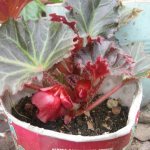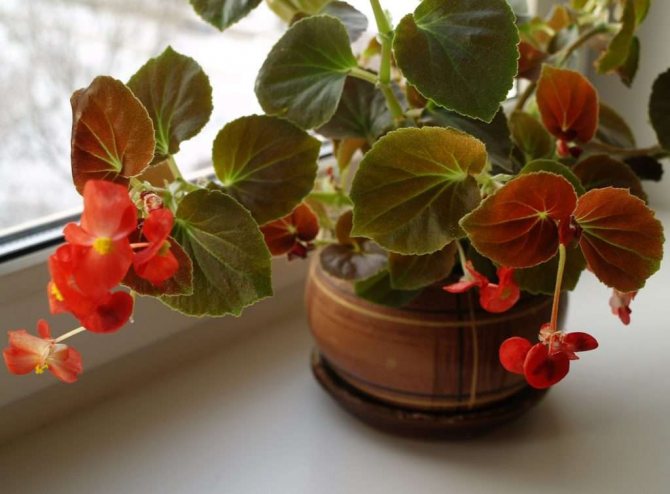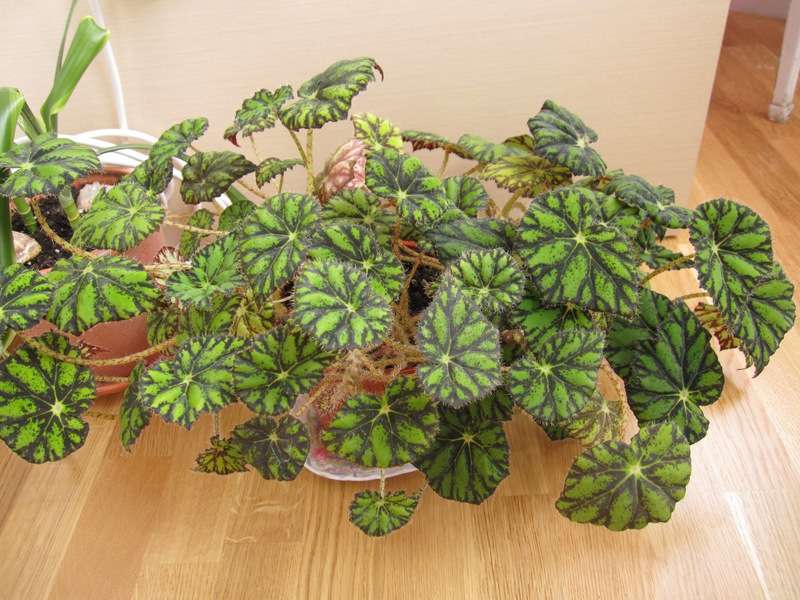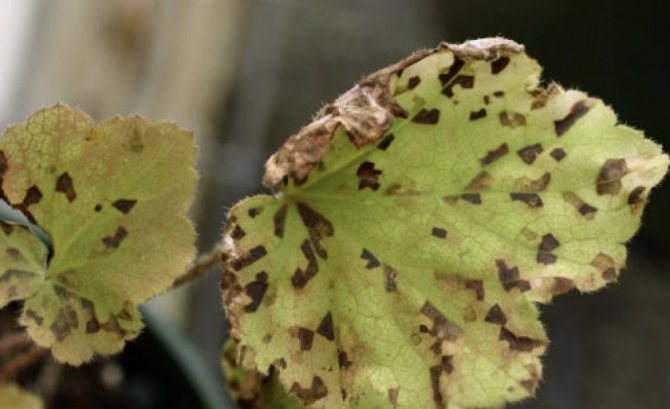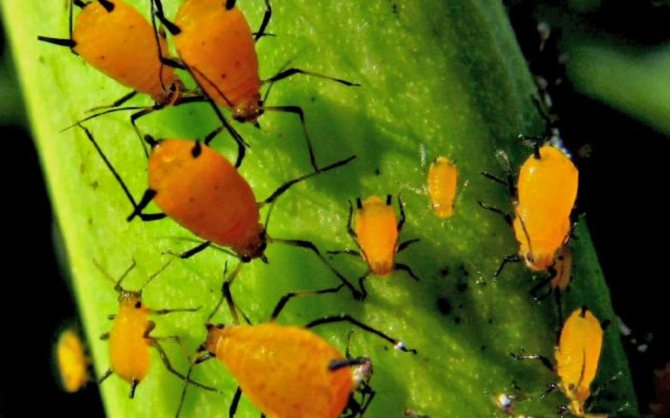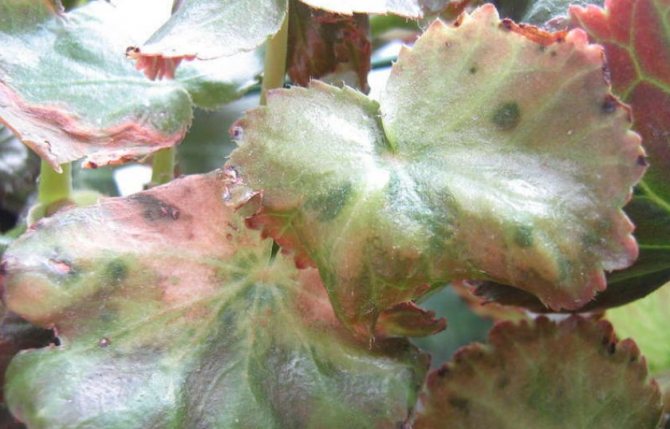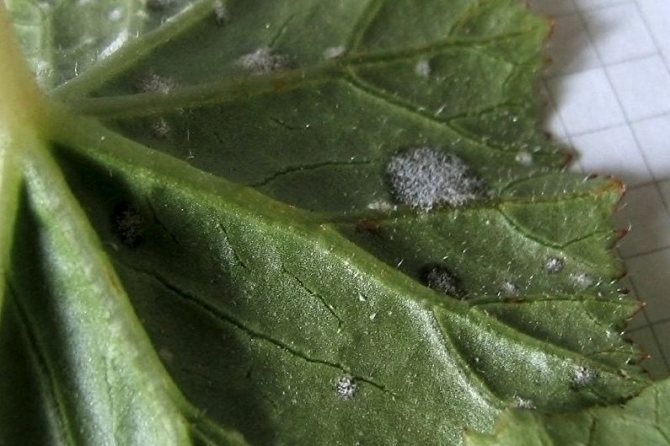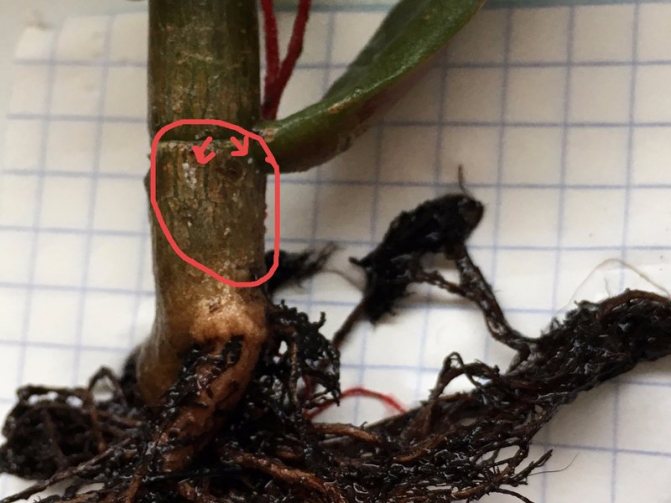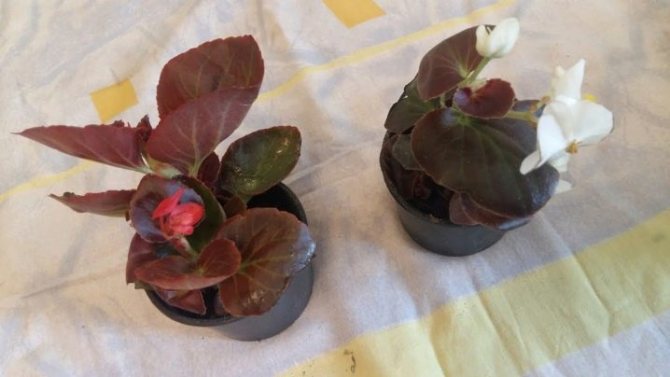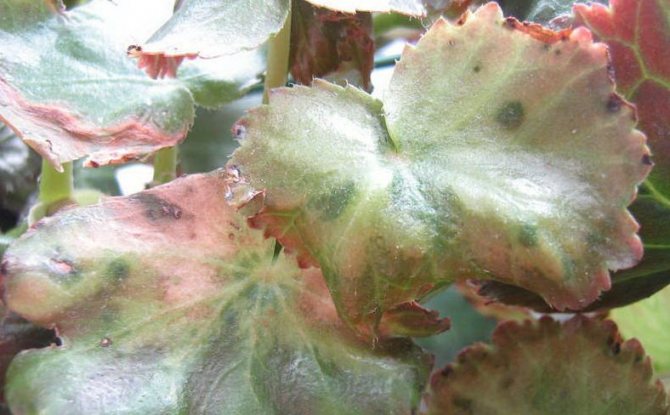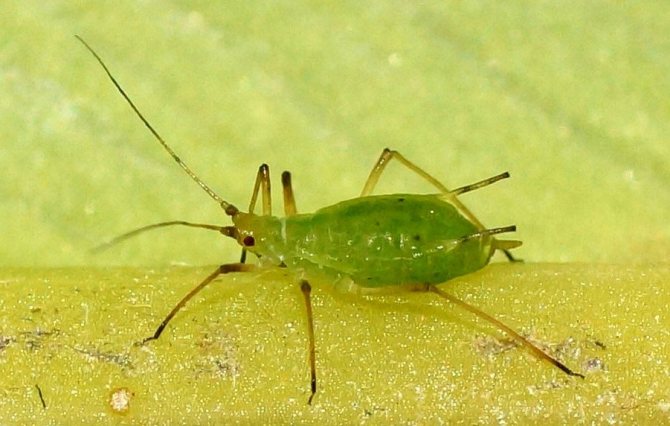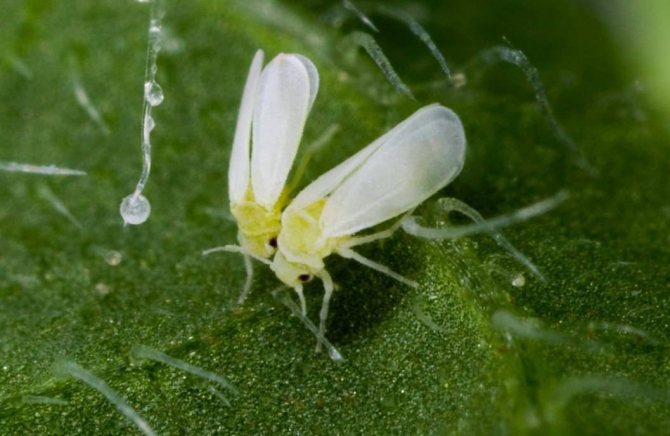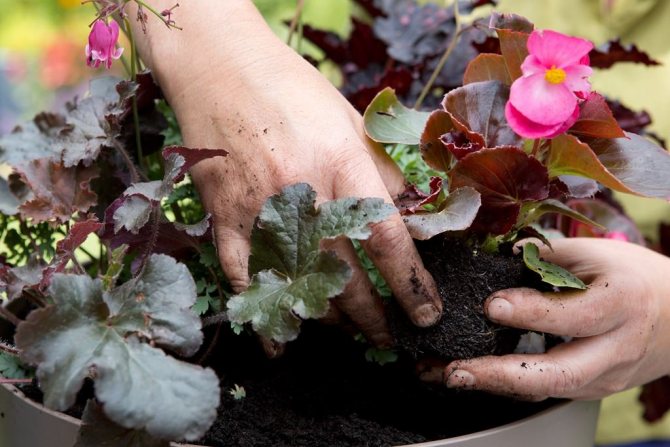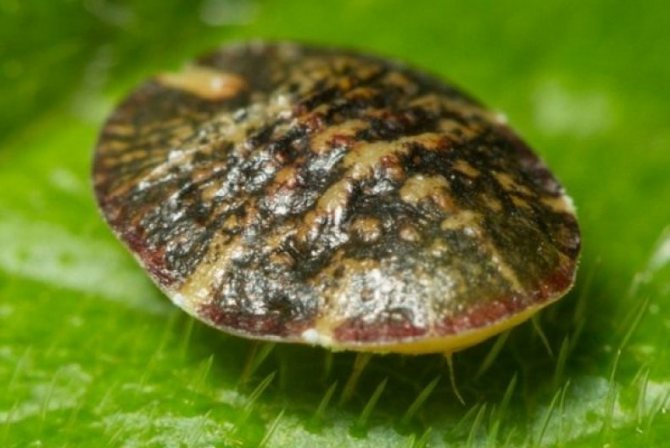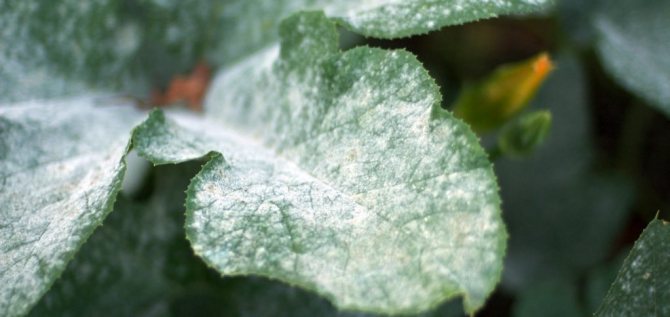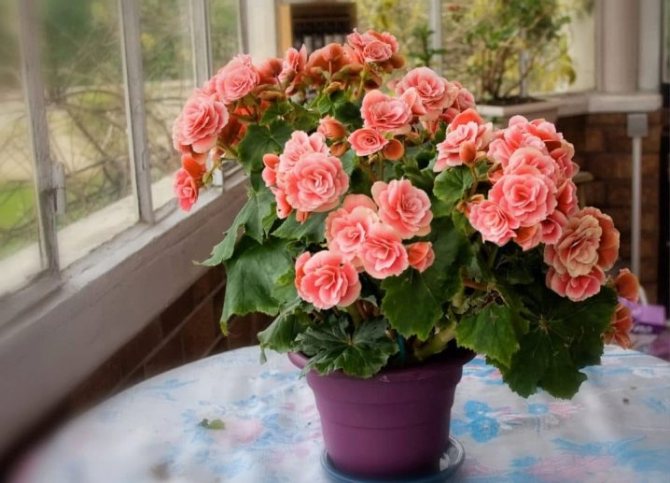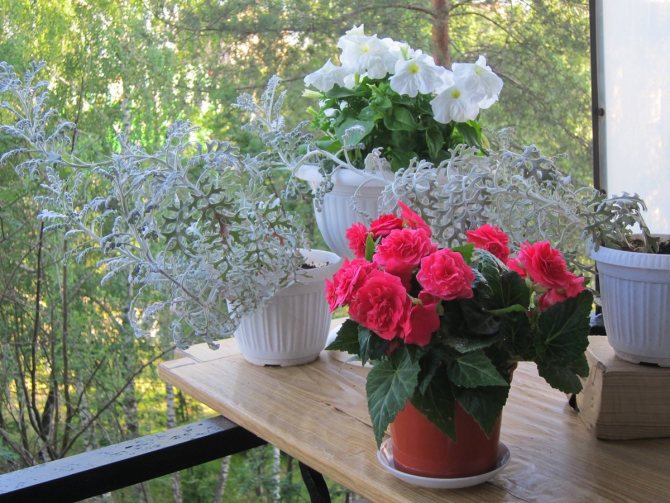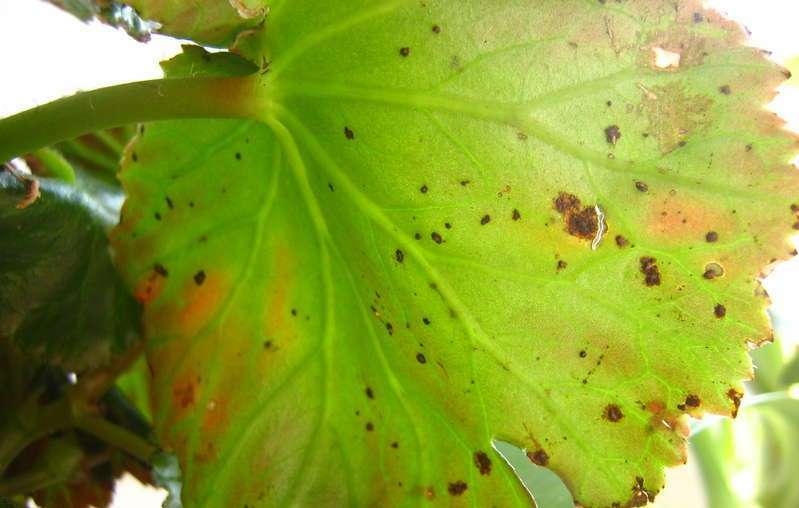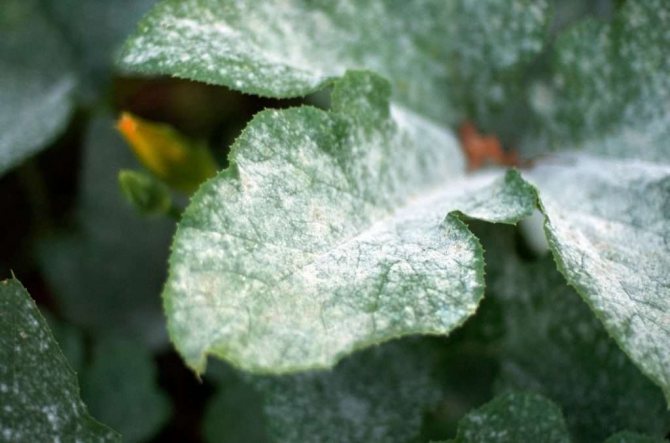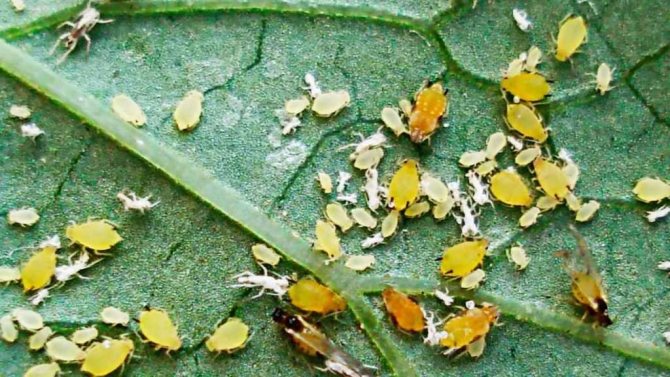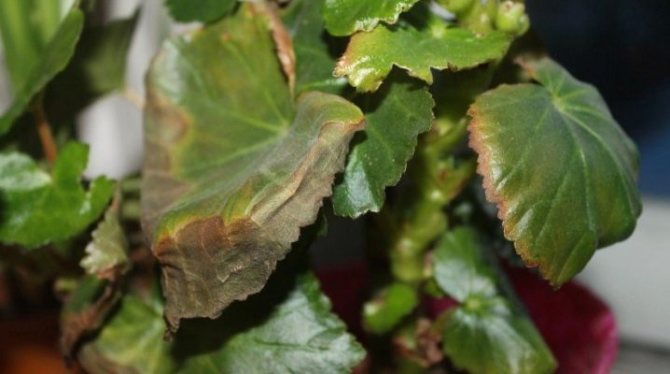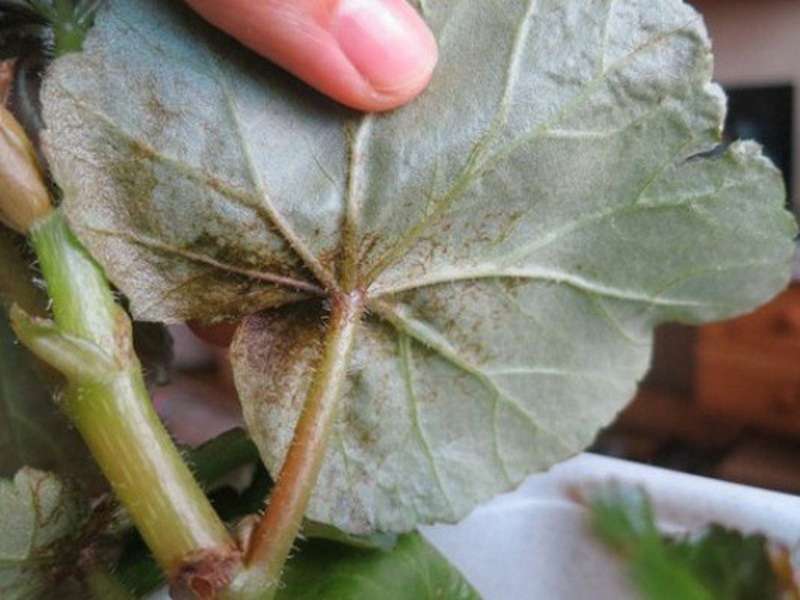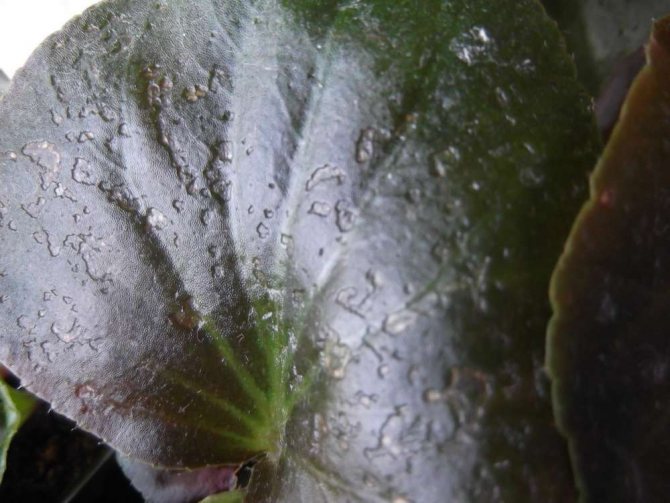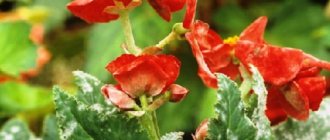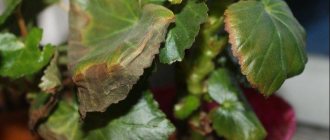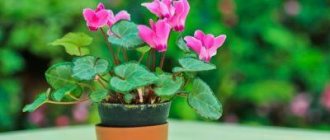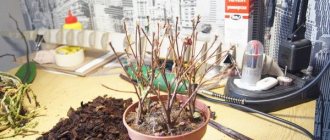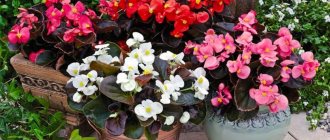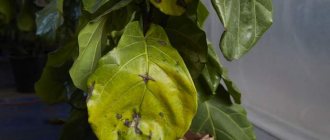Begonia is named after Michel Begon, who in 1687 led an expedition to the Antilles in the Caribbean to collect plants. Then flowers were found that could not be attributed to any previously known species.
Begonia is deciduous, bush and tuberous... The latter most often grows in gardens. Due to the huge number of varieties in ornamental gardening, there is no single classification of begonias. The most popular variety in Russia is royal begonia, one of the most unpretentious. But even she gets into trouble.
Illiterate care
Why do the leaves of room begonia curl and dry? This can happen due to a change in the place of residence of the plant, for example, if a pot with a flower is moved from the room to the balcony. Some varieties of begonias are extremely negative about such movements, and as a result, the leaves wither and fall off.
If you are faced with such a problem in winter, then yellowing of the leaves can provoke dry air. What to do in such a situation? To increase the humidity of the air in the room, it is necessary to put a reservoir of water near the flower pot and do spraying. During cold weather, flowers should be removed away from batteries and radiators. Outdoor begonias can also suffer from dry weather or lack of moisture in the soil.
Another reason begonia leaves dry at the edges and then turn brown is cold tap water. It is necessary to water the flower with warm, settled water at room temperature.
Why do begonia leaves wither and curl, what to do? With an insufficient amount of soil moisture, the tips of the leaves dry out and then turn brown. To save the leaves, their surface should be sprayed 2 times a day with a sprinkler, and the plant should be watered abundantly. But the watering regime must be correct, begonia must not be poured, since excessive moisture can lead to rotting of the root system, and in this case the leaves fall off.
Why do begonia leaves turn yellow and curl? In addition to moisture, the foliage of a flower withers and dries due to insufficient amount of light or from an excess of it. Indoor begonia needs bright and diffused lighting. Direct sunlight should not be allowed, otherwise the leaves turn yellow and curl.
Taking care of this indoor flower is not at all difficult even for beginners. Room temperatures are good for him. In summer, the optimal temperature range will be 15 ... 20 ° С, and in winter closer to 15 ° С. Begonias do not like direct sunlight, so they should be kept on windows facing west or east.
Important! Begonia does not tolerate dry air and it needs to organize its humidity of at least 60%.
Leaves turn yellow and dry and curl around the edges
Reasons for indoor plants
- Plant falls into an unfamiliar environment for him... For example, with the onset of spring, vents and windows are opened in apartments, a draft arises in the apartment, which begonia does not like very much. Or, knowing that begonia is light-loving, they put it on the balcony, wanting to please with the sun and warmth. And they achieve the opposite result.A plant that has received stress begins to rebel, the leaves dry up and wither.Decision: Return the flower pot to its usual conditions - on a lighted warm windowsill.
- If a leaves dry and turn yellow in winter, the fault is the begonia's love for a humid environment. Usually in room conditions they are grown on windowsills, under which are located steam heating radiators. The air in the apartment is dry.Decision: Place the flower pot in a different place. If this is not possible, you can place a cup of water next to it. Regular spraying with water will also help.
We moisten the air by spraying, being careful not to get on the plant, especially on the buds.
- Lack of trace elements.Decision: Pamper with regular fertilizing with complex fertilizers. Or use potassium nitrate.
Reasons for garden plants
- Hot and dry weather insufficient irrigation.What to do: adjust the water supply. But there is a small nuance here. The roots do not like constant dampness, so you need to make sure that the earth is moist, but well ventilated and not constantly wet.
Diseases
For the prevention of any disease, you need to adhere to several rules:
- Gray rot.Symptoms: Gray watery spots appear on the leaves. Flowers and stems gradually become slippery and slimy, the leaves dry up and begin to fall off. The reason is excessive moisture.
Treatment: Spray with 1% Bordeaux mixture or copper and soap solution (a little tar soap, 20 g of copper per liter of water). Treat with benomyl. Powdery mildew - white bloomSymptoms: spots with a white bloom appear on the leaves. If you do not take action, they increase in size and gradually cover the entire leaf completely, gradually the leaves turn brown, curl and dry out.
Treatment: Spray the plant with either 0.05% morestan or 0.05-0.1% foundation. For prophylaxis, spraying with a soap-copper liquid or a solution of colloidal sulfur is suitable. Ring spot.Symptoms: yellow-green spots or concentric lines appear on the leaves, they grow and turn into bronze spots. The cause is the so-called tomato virus carried by sucking insects such as thrips or aphids.
Prevention: Watch out for pests.
Treatment: it is better to destroy the flower, since the treatment does not give results. Bacterial spot - brown spotsSymptoms: small glassy watery spots form on the underside of the leaf. Gradually, they turn brown and capture the stems and buds.
Prevention: Spray every two weeks with 0.5% copper oxychloride solution.
Treatment: It cannot be treated, the flower must be destroyed so as not to spread the infection, the pot must be thoroughly disinfected, it is better to discard the earth and replace it with another.
Darken (flowers turn black)
- Water gets on the flowers during watering. Decision: water at the root, preventing drops from falling on the buds and on the edges of the leaves.
- Lack of moisture for foliage and flowers, for example, in hot and dry summers or in winter on a warm windowsill.Decision:
- Install a flowerpot with a flower on wet expanded clay.
- Using a spray bottle humidify the air around the plant, being careful not to get water on the buds.
The flower does not develop the root system, withers
There are two types of begonias - root begonia and tuberous begonia.
For both species, the wilting of the root system occurs due to over-watering... If water stagnates in the ground, and the roots and tubers begin to rot, the plant withers, the leaves fall off, in this case it is necessary to limit the amount of moisture supplied.
Read also How to remove airiness in the heating system
The second reason is the infection of the flower nematodes... Since this is a viral disease, the plant dies.
And the third reason is that there are types of begonias that bloom only in summer, and in winter they need rest. In this case, there is no need to be afraid of drying out. Just need cut off all leaves, stems and flowers, and place the tubers in a closed container with dry sand or soil and store in a cellar or on a loggia at temperatures from plus five to plus ten degrees.
Buds fall
Begonia - very moody plant... Buds can fall off for a variety of reasons:
- Insufficient watering.
- Excessive watering.
- Dry air around the plant.
- Water got on the buds.
- Excessive feeding.
- Insufficient feeding.
- Move the flower pot from place to place. Even turning a few degrees can cause the buds to fall off.
Decision: Observing the plant, identify the cause, adjust watering and feeding. Do not under any circumstances change the location of the flower. There may be no flowers at all if you unknowingly acquired a plant that does not bloom.
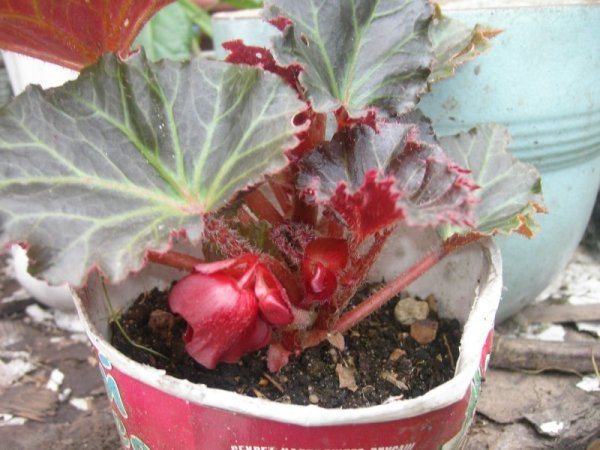
Begonia buds fall
Stem decay
The reason again in the wrong watering... Excessive moisture and getting it on the outlet provokes stem rot.
Why begonia leaves dry
Begonia is distinguished not only by lush and long flowering, but also by decorative leaves. When they begin to dry at the edges, the foliage loses its beautiful juicy appearance. If young foliage withers and dries, then the reasons lie in violations of care and maintenance, as well as in the appearance of diseases and pests.
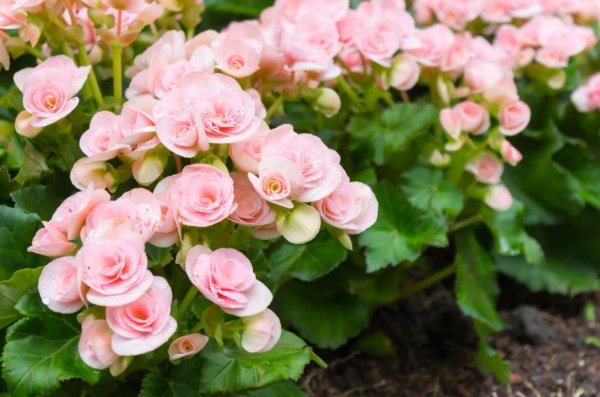

Not all begonias can tolerate rearrangement and environmental changes. Many growers make the mistake of bringing this flower to the balcony. This rearrangement is stressful for sensitive indoor plants and can affect foliage. The situation is also aggravated if the hot direct rays of the summer sun begin to fall on the flower. Most begonias do not tolerate them - they burn the foliage. A draft can cause the same situation.
Did you know? Begonias got their name in honor of the French quartermaster of the colonies and navy, Michel Begon. This plant was discovered by the scientific expedition headed by him to the Antilles in 1687. They were discovered and described by the botanist Charles Plumier, who was part of the expedition and was a friend of Begon.
Dry air
Begonia is a tropical plant that prefers a humid climate. Dry air negatively affects the condition of its foliage and flowers. Most often, the air becomes dry under the influence of heating devices in winter or during a dry hot summer.
If the plant is in optimal conditions for itself, and normal care is provided for it, then the reason for the wilting of the leaves along the edges of the begonia may be a lack of nutrients. This flower should be fertilized during the active growing season and flowering 2-3 times a month.
When choosing dressings, you should consider the type of begonia:
- decorative deciduous varieties prefer complex fertilizers with a high proportion of nitrogen ("Kemir", "Agricole");
- decorative-flowering varieties should be fed with potassium-phosphorus fertilizers ("Bud", "Blossom").
Dense soil
Poor water and air permeability of the soil leads to stagnation of water, and begonia does not tolerate this. Weak plant roots rot in such soil, and this is reflected in the entire plant, it withers and dies.
Did you know? Begonia leaves produce phytoncides that purify the air around them. This herb is useful for smokers and asthmatics.It is believed to increase energy tone and performance.
Diseases
Foliage lesions can cause various diseases. Most often, they develop against the background of waterlogging. Let's consider the most common diseases.
Why do begonia leaves dry? There may be several reasons:
- Conditions of detention that are not suitable for the plant;
- Lack of trace elements;
- Diseases.
Lat. Begonia
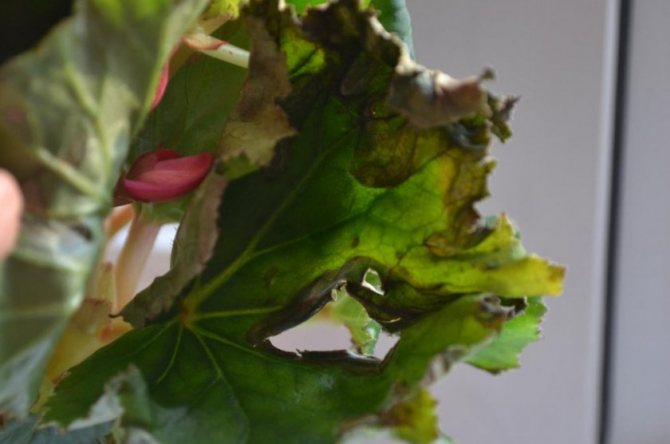

It should be noted that drying out can be a common process in the normal development of a plant, in which the death of old leaves is natural.
We offer you to familiarize yourself with: Black chokeberry blanks for the winter
The plant must be watched. You need to start sounding the alarm when the phenomenon becomes widespread.
What to do for prevention?
Any especially new advice on preventing leaf drying has not appeared over the past decades, probably. Everything is as old as the world. Simply observe the optimal growing conditions for Begonia:
- the place is bright, but without direct sunlight;
- regular watering with water without chemical impurities;
- inadmissibility of drafts;
- optimal temperature regime (18-2 degrees Celsius);
- a well-chosen complex of fertilizers.
Note! If the lowest leaves of Begonias begin to dry out, there is no need to worry at all. This is a natural process of withering away old leaves of a plant.
You need to start sounding the alarm only when this unpleasant phenomenon becomes widespread. Just pinch off the wilting leaves, and then the young foliage will receive more nutrients and it will become more oily and saturated.
Lack of nutrients
Professional florists give the following useful tips for keeping begonias:
- For irrigation, take well-settled or filtered water at room temperature. For softness, it can be acidified. In cold weather, watering is done with warm water and only when the soil is dry.
- It is advisable to periodically loosen the soil by about 1 cm in depth in order to improve the flow of oxygen.
- The room should be regularly ventilated for fresh air, but without drafts for plants.
- Deciduous begonias should properly organize a dormant period in the fall.
- A pot with begonias should be placed on a well-lit side, but without direct sunlight, which can cause burns.
- Provide the required level of humidity. To do this, carry out small spraying with a spray bottle. It should be noted that they spray the air near the begonias so that moisture does not get on the leaves - this can cause brown spots. It is recommended to put a container of water near the flowerpot or put the pot in a tray with wet pebbles to maintain humidity when the room is dry.
- Regularly feed the growing plant.
- When replanting, use loose nutrient soil with a pH of 5.5–6.5. You can buy ready-made soil for begonias, or you can make a soil mixture based on leafy earth, peat, sand and humus.
- Watering should be carried out in moderation so that the water does not stagnate in the pot, as this leads to the appearance of many fungal diseases. It is recommended to water at the same time in the morning. During the period of ovary and flowering, the plant should be watered more abundantly.
To organize such care of begonia so that its leaves do not wither, even for a beginner. You should spend quite a bit of time, and your plant will delight you with its flowering appearance.
If the plants are not fed, then troubles can arise. Experienced growers recommend fertilizing plants from spring to autumn 2 times a month. When begonias are in bloom, they need to be fed with liquid fertilizers. With abundant flowering and the appearance of buds, fertilizers should be applied, which contain phosphorus and potassium.
You should not use fertilizers that have a lot of nitrogen - it is practically not useful for begonias. But for decorative leafy varieties, nitrogenous fertilizers are needed. It is very good to feed begonia with potassium nitrate, fertilizer should be applied once a month.
Indoor begonia: causes of drying and falling leaves
Potted begonia dies, dries and leaves fall off due to:
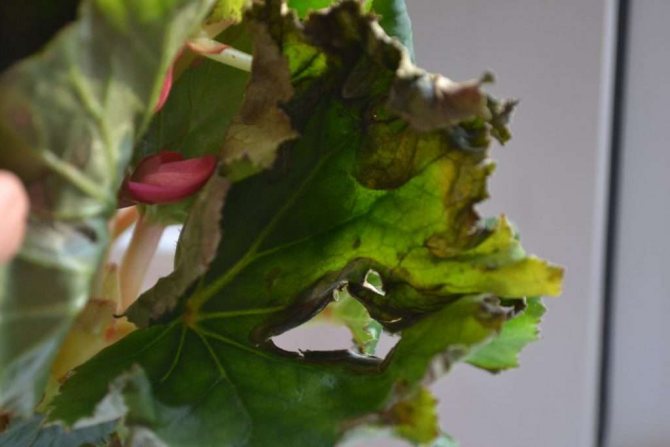

- drafts from windows open in spring;
- exposure to direct ultraviolet rays, causing burns to the plant while on the loggia or sunny south window;
- dry air in winter due to the operation of heating devices and batteries;
- lack of fertilizers or an incorrectly selected complex for feeding begonia;
- damage from pests;
- diseases with a sharp change in growth conditions;
- stress due to carelessness and poor water chemistry.
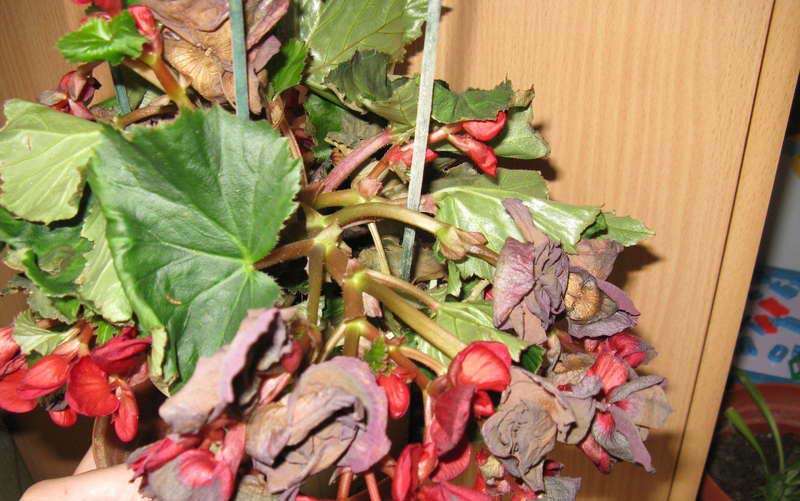

It's important to knowwhy begonia withers in a pot when feeding: there may be an excess of nitrogen in them. Flowers and buds dry up and later fall off after spraying them with water. Drops of water should not fall on the buds and deep into the flowers.
When should you not be afraid?
In some cases, you shouldn't worry about leaves drying out. So, drying of leaves along the border can happen due to natural aging. This process takes place at the bottom of the plant where the old leaves are located. In this case, you can tear off the dry foliage or carefully cut it off with a sharp knife. The tool must be disinfected before use by wiping with alcohol.
It is advisable to sprinkle the place of cut or breakage of foliage with wood ash or activated carbon powder. Some varieties of flowering begonias shed their leaves themselves at the onset of the cold season, in order to re-grow from tubers in spring. Such plants should properly organize the dormant period.
Important! It should be borne in mind that the frequency of watering directly depends on the room temperature. At high temperatures in the summer heat, more abundant watering is needed - the soil should not completely dry out. If this happens, then in order to revive the plant, the pot must be soaked in water for a couple of hours.
Care: soil, watering, temperature
When begonia leaves dry, it is necessary to determine the cause, choose ways, means and methods of elimination.
- The choice of capacity. The pots should be low, but spacious, there should be enough space for the root system. Preference is given to ceramic containers: they allow air to pass through. Before use, they are soaked in water for several hours. If the container has already been used before, be sure to thoroughly rinse it, disinfect it and dry it.
- Temperature changes. Reacts sharply to sudden changes in temperature, does not like drafts. This can happen when you turn on the air conditioner, heater, move the pot from a warm room to a loggia or balcony. When the first signs of wilting appear, it is worth returning it to its previous "place of residence", monitoring the room temperature. From October to January, when they are at rest, they are transferred to a cooler place, but the air temperature should not be lower than 12 degrees.
- Watering. It is recommended to use settled or filtered warm water, in no case should it be watered with cold tap water. Add a small amount of lemon juice or citric acid to it. Watering is carried out twice a week in hot weather and once in winter. It is desirable to carry out the procedure at the same time. Provide good drainage so that water does not stagnate. Waterlogging of the soil is unacceptable.
- Priming. The soil mixture is purchased in specialized stores or prepared independently from peat, compost, sand, leafy earth. The main requirement is that the soil should not have an increased level of acidity.
Dry indoor air may be a problem.In such cases, place containers with water, carry out regular spraying. Or place the pots on pallets of sand and pebbles, which are periodically moistened.
Pest and disease control
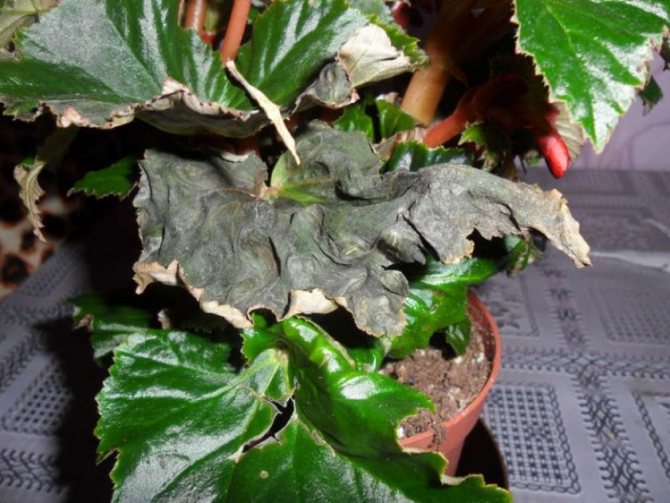

Why do tuberous begonia leaves dry and curl? A home beauty can have a lot of troubles if she is affected by diseases and insects. They usually appear due to illiterate care, bad weather conditions. Quite often, the flower can be affected by powdery mildew.
Symptoms of the disease appear on the leaves with white spots, which then spread throughout the leaf plate. The sheet turns dark and dries. How to save a plant from disease? For powdery mildew, you can use drugs such as Fundazol, Topaz, Fundazim.
During the growing season, the leaves should be crushed with sulfur crumbs or a colloidal sulfur solution should be used. In addition, you can use a soap-copper solution, which is prepared as follows: take copper sulfate 2 grams and tar soap 20 grams, then throw all the components into a small container (1 liter of water) and stir.
Gray rot may also form on the foliage. The disease is caused by humid and warm weather conditions when there is a large accumulation of dust.
You can identify gray rot by watery specks of a gray tint, the disease appears on the tops of the stems and leaves. Then the branches break and rot. Ovaries, leaves and flowers become slippery, crumble. You can save the plant with a solution of copper sulfate with soap or Bordeaux mixture.
Why do begonia leaves curl and crumble? In some cases, the plant can be attacked by spider mites, mealybugs, and aphids. Mostly pests appear due to a violation of care. How to save a flower? The plant must be treated with fungicidal preparations.
Sometimes begonia sheds its foliage due to aging. In this case, do not worry, this is a natural process. When the old leaves fall from the flower, with proper care, after a while new ones will appear.
If you follow all the rules for caring for begonia, then it will delight you with its gorgeous look for many years.
We suggest you familiarize yourself with: Black handsome zucchini variety - Sam-Village
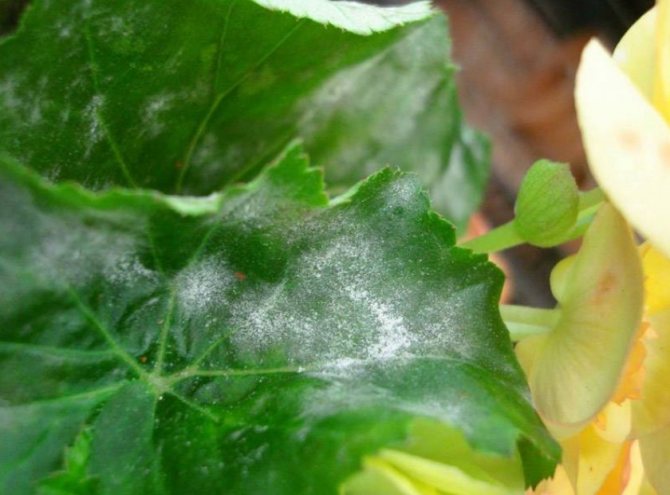

Diseases overwhelm the plant in case of improper care of it. If you adhere to simple rules, they will not be afraid of begonias.
Powdery mildew
If a white bloom appears on the leaves, we can confidently talk about the appearance of powdery mildew. As bacteria spread, the spots cover all the leaves. Over time, the leaves turn brown and dry.
Soap - copper liquid is also an effective remedy in the fight against the disease. It can be prepared as follows: for 1 liter of water, 2 grams are taken. copper sulfate and 20 gr. tar soap.
Gray rot
The flower can also be affected by diseases such as gray rot. The disease can occur in warm and humid weather when dust spores are more likely to develop.
A distinctive feature of the disease is the appearance of watery spots with a gray bloom on the tops of shoots and leaves.
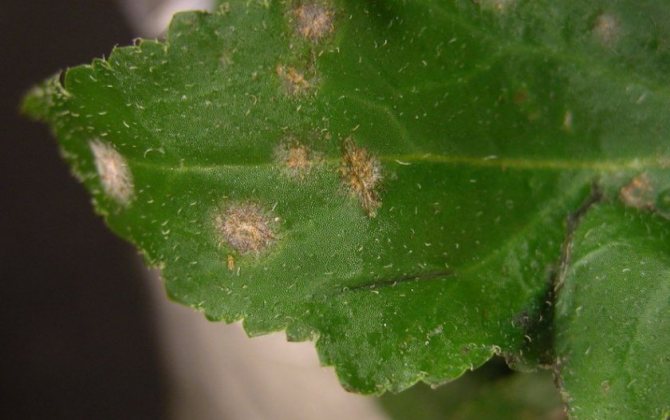

If left unchecked, the disease can spread to the stems of the plant. After that, they will simply rot and break. Flowers, leaves and buds curl and fall off.
To combat the disease, spraying with a Bordeaux mixture or soap and copper liquid is suitable.
Spider mites and aphids can also harm begonias. They like to sit on the back of the leaves and take all the juices from them.
You can get rid of the tick by spraying the flower with a soap and tobacco solution. And aphids are destroyed only with special drugs, such as feverfew.
Expert opinion
Yulia Yurievna
I have a large garden and vegetable garden, several greenhouses. I love modern methods of plant cultivation and soil mulching, I share my experience.
Ask a Question
Begonia leaves dry even when affected by a cucumber mosaic. When such an infection attacks, dry spots and yellowish rings appear on the crown. This disease cannot be cured. Begonia withers and dies.
The plant will have to be removed and destroyed. We recommend pouring boiling water over the pot and not planting other plants there for a while. The soil must be thrown away. If begonia grows in open ground, then we recommend removing it with a lump of earth, and pouring ash into the hole in the place of culture.
In the case of the development of powdery mildew, you can also use the preparations Fitosporin, Alirin-B, Planriz. If the defeat is very strong, you can use Strobe, Topaz. It is also important to reconsider leaving. Adjust the watering regime and humidity in general. Monitor the temperature, avoid stuffiness, if the flower is indoor.
Also, the reason why begonia withers may be downy mildew. First, soft light spots are noticeable on the foliage, and then the crown begins to dry and die off. The flower should be treated as with powdery mildew infection.
In case of infection of begonias with gray rot, dampness must also be eliminated. If the Bordeaux mixture did not give the desired effect, we recommend using Topsin, Euparen, Polycarbacin.
What to do if begonia leaves turn yellow, it withers and dies? There is a possibility that root rot is the cause. It is necessary to remove the flower from the soil, and examine the rhizome. If there are softened and rotten areas there, they need to be cut off, the flower should be planted in clean soil and a pot, and then treated with Benomil.
When attacked by ticks, soapy water alone is often not enough. When a begonia is damaged, the leaves dry at the edges, then they begin to fall off, the flower looks lethargic, a thin cobweb is noticeable on the shoots. To get rid of such a pest, repeated processing by Neoron or Aktellik will be required.
Another dangerous pest is whiteflies - small light-colored butterflies. It is difficult to remove them due to their rapid reproduction. At the same time, the leaves of begonia turn yellow and dry, because harmful insects suck the juices out of it. For their destruction, drugs Aktara, Mospilan are used.
Sometimes gardeners wonder why begonia dies if there are no obvious defeats and the care is correct. The cause may be nematode infestation. Over time, swollen areas and brown or light green spots appear on the leaves.
It is almost impossible to cure a flower from such parasites. It is important to take preventive measures initially. When cultivating begonias in a pot, the soil should be pre-roasted in the oven, and the area in the garden should be watered with boiling water before planting the flower.
If the plant has stopped growing and began to dry out, you need to look for false shields on it. They appear as small brownish or yellow growths on shoots and leaves. These pests will have to be removed manually using a brush or cotton swab dipped in alcohol or soapy water.
While watching the video, you will learn about growing begonias.
It is easy to cope with all the warnings and rules described above, and then begonia will smell beautifully in the house, and delight its owner.
Have you noticed a mistake? Select it and press Ctrl Enter to tell us.
We suggest you familiarize yourself with: What to do if Kalanchoe leaves turn yellow
Attention super FLY!
Begonia
Pests
Pest damage also leads to yellowing and drying of the leaves. And begonias have a lot of them, including large ones. Most often, you have to deal with large plant pests by manually collecting them from the leaves and stems of the plant. So you have to collect slugs, which are very fond of begonia stems and juicy leaves. Small insects and other "guests" can be sprayed with chemical insecticidal preparations or herbal decoctions and infusions.What small pests do you have to "fight"? Leaf nematodes, thrips and aphids love to settle on begonias. What to do in this case?
Leaf nematodes
This is a type of worm, the length of which is no more than a millimeter. If they hit begonia, light greenish wilting spots appear on the foliage. Shoot tips become irregular. Over time, the plant dies. For prophylactic purposes, a 0.05% solution of heterophos is used. In cases of severe damage, the plant is destroyed. The nematodes do not touch the flower ovaries, but the inflorescences still die, starting to dry, only the nematodes will begin to infect the delicate stems at the beginning of the flower.
Preventive measures
To prevent wilting of foliage, the following should be done:
- follow all the rules of proper care (watering, lighting, humidity);
- prevent overflow and complete drying of the soil;
- shade the plant from direct sunlight;
- do not rearrange to another place and protect from drafts;
- do not put a flowerpot near heating devices;
- for the prevention of brown spot, 0.5% copper oxychloride can be treated;
- for the general prevention of fungal diseases, it is recommended to water the flowers with a solution of the drug "Fitosporin-M" or "Immunocytophyte";
- when planting and transplanting, always use disinfected soil;
- begonia pots should not stand close to each other;
- yellowed and dry parts of the plant should be cut off, and the place of the cuts must be sprinkled with activated carbon powder;
- monitor the looseness of the soil and have drainage;
- it is necessary to inspect the flower, especially the leaves on the back side for the timely detection of pests and diseases;
- diseased specimens should be immediately separated from other flowers or disposed of so as not to infect neighboring plants.
External signs of the disease
In cases where begonia does not receive proper care or is attacked by pests, a chic and graceful flower turns into an inconspicuous stunted plant. There are several signs that indicate that it is sick:
- begonia leaves dry at the edges, while they acquire a brown color, begin to break or crumble;
- the inflorescences wither, and, not having time to bloom, they crumble;
- leaves turn black and curl;
- bright yellow spots appear on the leaf plate.
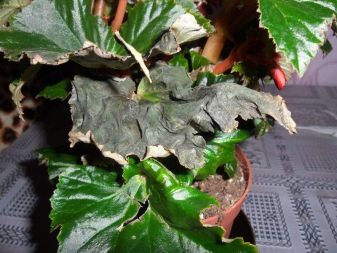

These problems can be caused by various reasons. If one or more of them are found, you must immediately take the necessary measures to treat the plant. Otherwise, the flower may die.
Conditions of detention
A sharp change in the place of cultivation Begonia is more suitable for home cultivation, as it is a heat-loving plant native to South America.
A change in the usual climate, for example, if the plant is taken out on the balcony, can lead to the fact that the leaves dry quickly. If this happens, the flower must be returned to its original place, the dried leaves must be cut off, and a complex of fertilizers must be applied.
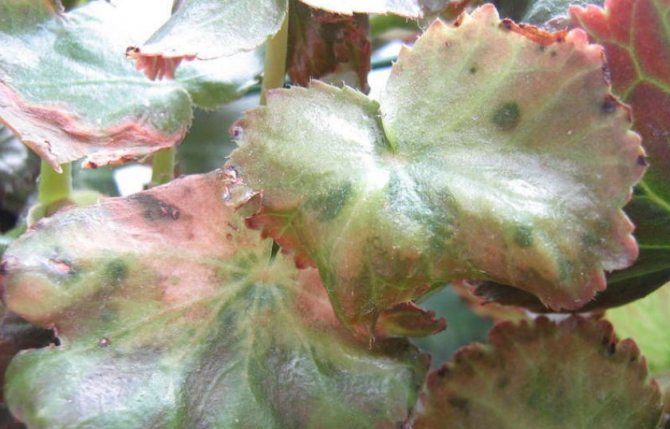

Plants feel best on windowsills from the southwestern and southeastern parts of the house.
Reaction to insufficient air humidity. Begonia leaves can begin to dry out in winter. This is due to the peculiarity of some specimens and their reaction to dry air.
This problem can be solved by removing the plant away from heating appliances, since it is they that lead to dry air around. If this is not possible, a vessel with water should be placed next to the flower and the begonia should be sprayed daily.
The same problem can be seen with bushes that grow outside. The reason is the same - dry air.
One of the types of flowering garden begonia
To eliminate the need for frequent watering and spraying the plant in the morning and evening.
It should be remembered that stagnant water on the roots can lead to the fall of the lower leaves. Therefore, watering should be moderate, but sufficient.
It must be remembered that spraying dropped leaves is unacceptable.Water droplets can cause burns on the leaves, which turn into ugly dark spots.
You can also not spray a flower with "fluffy" leaves. To humidify the air, you just need to spray water from a spray bottle around the begonias.
Correct watering. The best watering is considered to be at the same time, while evenly moisturizing the soil.
In the summer, watering is carried out often to prevent the soil from drying out. With a cold snap, watering becomes moderate, it is advisable to carry it out with warm water.
Begonias are very sensitive to poor quality tap water with a high content of fluorine and chlorine. For watering a flower, it is better to use filtered, settled or melt water.
The optimum air temperature for begonias is 18 degrees. In summer, it can withstand a maximum of 24 degrees. The plant does not tolerate drafts. It reacts to an increase and decrease in temperature by drying the leaves.
Damage to the root system during transplantation. Carefully transplant the plant into new soil and a larger pot. Since the damaged roots cause the leaves to dry out.
If the plant is purchased from a store, you do not need to immediately transplant it into new soil and pot, as it will need to acclimatize for a while. You need to replant indoor begonias once a year, while you need to make sure that the plant does not come into contact with the ground.
Variegated begonia
Begonia is best planted in clay pots that are highly breathable.
As a soil for it, as a rule, loamy soil is used with the necessary selection of minerals and trace elements.
A soil consisting of sand and peat mixed with leafy soil in a 1: 2 ratio is ideal. The soil should have a low level of acidity, as well as be loose and light.
Begonia is a finicky plant. In order for it to please with its beauty for many years, you need to listen to the advice of professionals and follow all their recommendations.
Measures to eliminate wilting leaves and buds
If the begonia in a pot is standing in a draft, then you need to change the place of its localization. During the period of active sun, a shade or partial shade is created for the plant, or it is installed indoors on the eastern or western windowsills. Dry air will become humid after placing a container of water next to the flower. It is recommended to place a container with expanded clay under the pot, then excess water will accumulate in the pan and create air humidity. If the radiators are too hot in winter, your beauty should be moved to another place, away from the heat source.
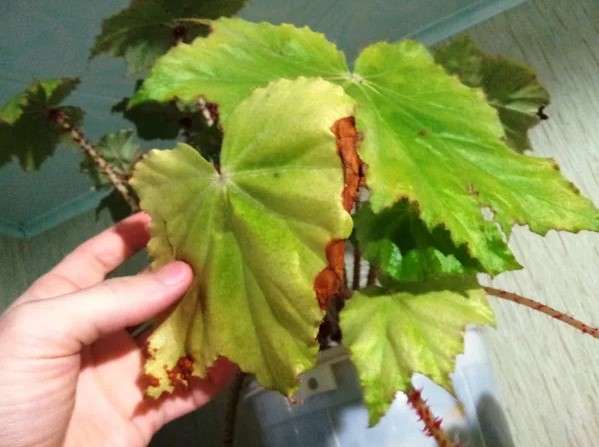

Complex liquid fertilizers with a small percentage of nitrogen must be fed to begonia every 10 days, especially with active growth and during the flowering period. With a sharp change in temperature, illumination, moisture regime of the root system, when transplanting into a larger pot, plucking sprouts, the flower gets stress. That is why begonia leaves turn yellow and dry, buds fall off. But you cannot do without periodic pruning of the plant, as well as from reproduction by cuttings. Then the stalk should be cut from the top (tip) of the stem or from the middle 8-12 cm in size. The slices should be dried, and the begonia should be watered with standing water or rainwater for 24 hours. It is not worth filtering the water, so as not to remove useful elements along with harmful elements.
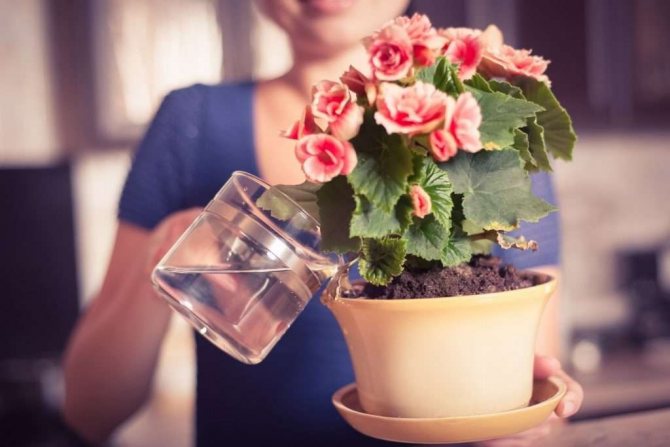

Around the garden begonia you should do:
- weeding and removing weeds that aggravate its development;
- place the bushes at a distance of 50 cm or more from each other;
- during the period of active flowering - feed with phosphorus and potassium;
- observe the rules and regimen of watering and fertilizing;
- protect from drafts and direct sunlight by other plants, creating a slight partial shade.
Top dressing
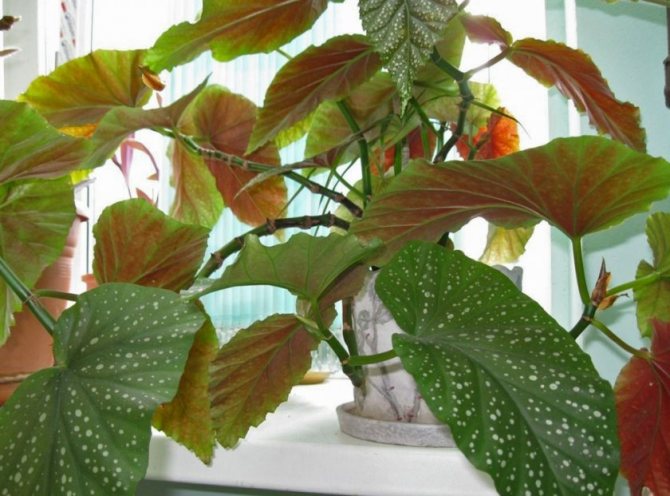

Fertilizing the plant becomes irreplaceable if, if all the above conditions are met, the leaves dry up anyway.
Begonia feeding should be carried out no more than three times a month from March to September.
For this, complex fertilizers with a minimum amount of nitrogen are suitable, since it has a bad effect on the further growth and development of the plant.
Potassium nitrate is sometimes used. It is applied under the plant no more than once every two weeks.
In the heat, you can spray the bush with humate, epite, zircon. But, as soon as the plant has faded, feeding it should be stopped.
However, there are decorative deciduous begonias. Their feeding should be carried out precisely with nitrogenous fertilizers.
Begonia found on every windowsill
It must be remembered that improper feeding can also cause the leaves to dry out, since begonia is accustomed only to ideal growing conditions.
Tags: begonia, wither, do, leaf
About
«Previous post
Ways to fight
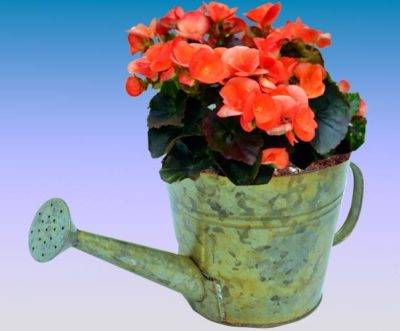

If the buds of the begonia began to fall off, then the first thing to do is to change the conditions of its keeping. Try changing the watering schedule. In summer, begonias need to be watered abundantly, but do not allow water to stagnate in the pan. In winter, the flower is watered less. Watering of tuberous begonia, which hibernates at this time, is completely excluded. All tips for winter begonia care can be found here.
Comfortable temperature for begonias: 20 - 22 ° C, and in winter - 16 - 18 ° C. At temperatures below the buds of the plant fall off, and the leaves acquire a bright red hue.
Lighting in the room plays an important role for begonias. It should be bright enough. In winter, it is better to exclude the best direct light from hitting the plant, to provide the flower with diffused lighting, otherwise sunburn may occur.
The flower is not too picky about the choice of soil, so you can buy absolutely any one in an ordinary flower shop. If you select the soil yourself, then the best option for a flower would be a mixture of turf, needles and leafy earth with the addition of sand and peat in equal proportions.
If the flower weakens, then you can try to apply mineral fertilizers. During the flowering period, fertilizers are applied once every two weeks., and in winter - once every two months. You can read about how to feed the plant for abundant flowering in this article.
If the buds of a flower fall off, then the plant may have pests. Then you need to urgently take measures to save the plant, otherwise the begonia can fade completely and ultimately die.
The most common diseases in begonia are:
- Gray rot. Light brown spots appear on the leaves, a fluffy bloom appears on flowers and buds.
- Powdery mildew. The appearance of a gray-white bloom or dark brown balls on stems and young shoots.
- Bacterial spotting. The appearance of small watery glassy spots on the underside of the leaf.
- Ring spot. The appearance of a flower of yellow-green concentric lines on the leaves. Subsequently, they turn into bronze spots and necrosis.
- Aphids and red spider mites.
You can save a flower during rot or powdery mildew by removing infected leaves and reducing watering. The room must be constantly ventilated. In case of complications, timely treatment is carried out with a copper-containing fungicide (Bordeaux mixture) or a solution of copper sulfate (2 g) and laundry soap (20 g), which are mixed in one liter of water.
With bacterial and annular spotting, the affected plants are destroyed, the infected soil is disinfected.
If the plant disappears from aphids and spider mites, then insecticide treatment can help begonias. Read more about the diseases and pests of this plant in another article.
dacha.expert
How to save begonia?
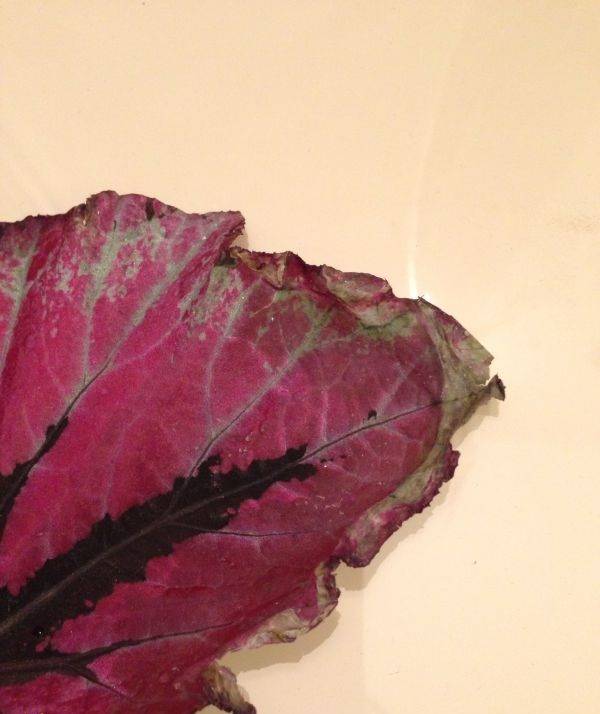

Why do begonia leaves turn yellow? Begonia leaves dry at the edges if the flower does not receive enough moisture. The plant is watered when the top layer of the soil dries slightly.Otherwise, the flower may dry out. The second reason why begonia leaves dry is a low level of air humidity. This is especially noticeable in winter, when heating devices are working in the room. They dry the air. Regular spraying of the flower is more suitable here.
Leaves dry if begonia is poured. Excessively wet soil leads to root rot. The damaged root system is no longer able to absorb moisture and nutrients from the soil, which affects the leaves. A clear sign of waterlogging in the soil is stem rotting. In this case, the plant is rarely saved. To prevent the plant from dying, you need to water it after the top layer of the soil dries. In the case of waterlogged soil, reduce watering, increase the number of sprays. Feeding is not recommended.
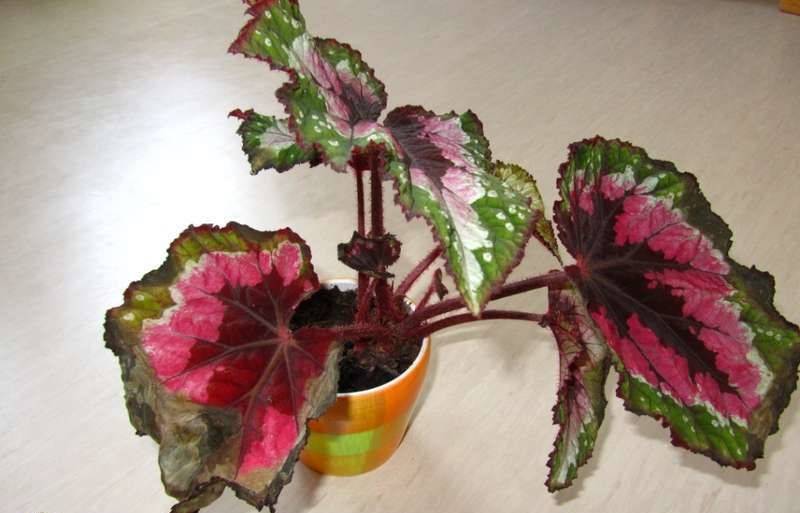

Begonia leaves dry at the edges. Begonia leaves dry at the edges and curl if the air humidity is low and the watering of the flower is insufficient. Do not dry out the soil in the pot. Between waterings, only the top layer of the soil should dry out. Begonia leaves dry out due to lack of light. You need to place the flower on the windows on the south-east or south-west side of the house. However, direct sunlight is harmful to the flower, which leaves burns on the leaves.
Why does begonia wither? First of all, you need to decide on watering the flower. The soil in the begonia pot should be slightly damp. Secondly, the plant needs moist air. However, you cannot spray the leaves themselves. In this case, brown spots form on the leaves and flowers of the begonia. It is necessary to spray the air around the plant.
Begonia withers if the roots rot. This happens when the soil is waterlogged. Also, the flower can be hit by a nematode or a variety of rot. The latter are viral diseases, and therefore it will not be possible to save the flower. In the case of root decay, watering should be reduced. In some cases, the flower is transplanted with a complete replacement of the soil.
The beauty of begonias cannot but impress; in all species of this plant, everything is beautiful - both the brightness of flowers and the variety of leaves. Each variety is able to decorate both the room and the flower bed in the garden. Begonias are appreciated not only for their beauty, but also for their relative unpretentiousness - the flower does not seem very capricious to the conditions of detention, and, having taken root, it will delight the owners with a healthy and rich look for a long time. But often, even experienced florists are faced with various difficulties. Drying and falling leaves on begonias are the most pressing problem. Why is this happening and does it not indicate the imminent death of the flower? If this problem has already occurred, how can you prevent it or fix it? Possible causes of leaf drying: lack of moisture One of the main conditions for the health of a flower is the correct choice of conditions. The plant cannot help itself, and therefore signals to the owners about problems in its condition in all ways available to it. It sends such an SOS signal: the leaves of the room begonia are drying up. What to do in such cases - the person himself must think. There may be several reasons for the drying of the leaves, but the most common is errors in watering and the place where the plant is kept. Begonias love moisture, but watering should be uniform, the flower does not tolerate overdrying of the soil or waterlogging. Begonia is also very sensitive to dry air, and this problem is very common in apartments in winter. You can also moisten the plant itself - sprinkle it regularly with water from a spray bottle - but this water procedure is good for varieties with smooth leaves. Around begonias with fleecy leaves, it is better to simply spray water, or put a container of water next to the pot. Choosing a place for a flower An important condition is the place where the flower will stand. Begonia loves light, but not direct sunlight - bright sun can cause burns and, again, excessive dryness.It is best for the plant to be in the southeast or southwest window. Begonias will not be very comfortable even in a draft, this must also be taken into account when choosing a place. The same as the air temperature in the room - it should not be moderate, not higher than + 25 ° С, but also not lower than + 15 °. Lack of top dressing But it also happens that even if all conditions of keeping are observed, the leaves dry on begonias. What to do in this case? Remember feeding the plant. Lack of important elements is a fairly common reason for the loss of leaf mass, especially during the period of active growth and flowering. It is enough to feed begonias three times a month; it is best to purchase liquid fertilizers for this for beautifully flowering plants. Plant stress Stress is experienced not only by people, the flower is also a living organism. By drying out, it can react to careless handling, for example, to a sharp change in the place of growth. Moving to a place with different lighting, changes in air temperature - all this can provoke drying of the leaves. Sometimes the plant begins to shed its leaves after transplanting into fresh soil, in a larger pot. It would seem that the flower should feel better, but it dries! But, perhaps, during transplantation, the roots or stems were damaged, and this cannot remain without consequences. The desire to "take a shoot" can also damage the flower. Of course, this can be done, some types of begonias are best propagated by cuttings, some even need regular pruning, but you need to know where and when you can take this cutting most painlessly. Diseases of Flowers A common cause of leaf drying is flower diseases and pests. Cuttings and leaves of begonia can be affected by fungal diseases, which are most often caused by an excess of moisture. The condition of the core of the bush and the lower leaves must be monitored in order to notice the appearance of signs of diseases such as powdery mildew or rot in time. If they are still present, it is necessary to remove diseased leaves and reduce watering. And, finally, the lower, "oldest" leaves of room begonia dry up simply because their lifespan has expired. You should not immediately take this as a sign of the disease, it is enough just to break off the dried leaves along with the cuttings. As we can see, there can be many reasons why such a home decoration as indoor begonia has dry leaves. What to do in such cases is not difficult to figure out, knowing the needs of your flower and knowing how to help him in difficult situations in time, and she will not cease to delight with her unusual, bright beauty.

